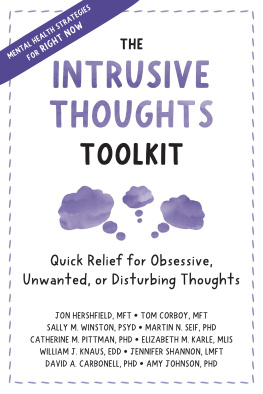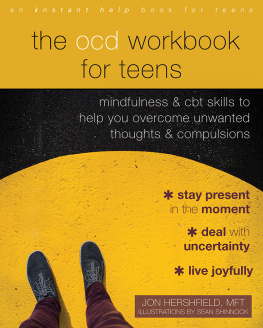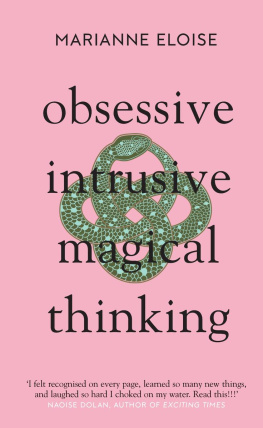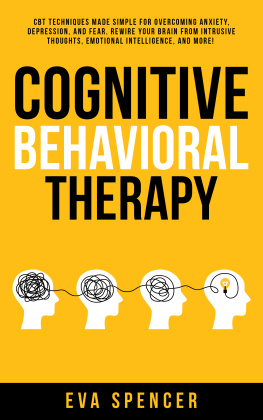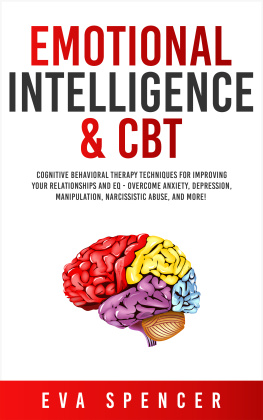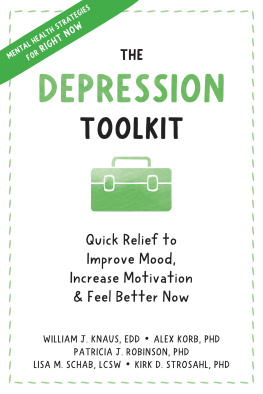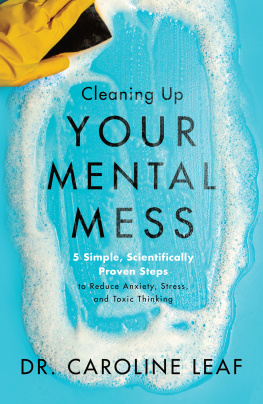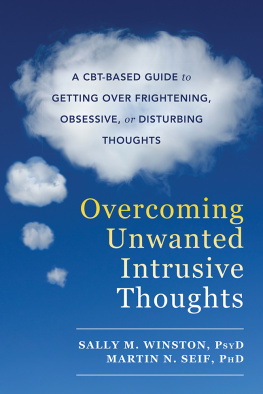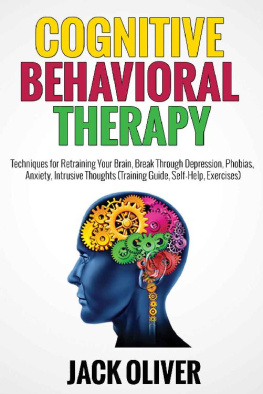Publishers Note
This publication is designed to provide accurate and authoritative information in regard to the subject matter covered. It is sold with the understanding that the publisher is not engaged in rendering psychological, financial, legal, or other professional services. If expert assistance or counseling is needed, the services of a competent professional should be sought.
Distributed in Canada by Raincoast Books
NEW HARBINGER PUBLICATIONS is a registered trademark of New Harbinger Publications, Inc.
Copyright 2023 by Jon Hershfield, Tom Corboy, Sally M. Winston, Martin N. Seif, Catherine M. Pittman, Elizabeth M. Karle, William J. Knaus, Jennifer Shannon, David A. Carbonell, Amy Johnson
New Harbinger Publications, Inc.
5674 Shattuck Avenue
Oakland, CA 94609
www.newharbinger.com
Chapters 1, 3, 5, 7, 9, and 12 include content adapted from Overcoming Unwanted Intrusive Thoughts by Sally M. Winston and Martin N. Seif
Cover design by Amy Shoup; Acquired by Jess OBrien; Edited by Joyce Wu
All Rights Reserved
Library of Congress Cataloging-in-Publication Data on file
Contents
Introduction
Intrusive thoughts can appear in your mind at any time, without warning or signal. When these thoughts are persistent, repetitive, and disturbing, they can cause a great degree of distress. If youre suffering from these kinds of thoughts, you can feel hopeless, as if your own mind has turned against you.
Even worse is the sense that the more you fight against these thoughts and try to deny them, the stronger they become. Millions of people grapple with the challenge of distressing intrusive thoughts. Some have sought help and been diagnosed with obsessive compulsive disorder (OCD), social anxiety disorder, panic disorder, or other conditions, and others have dealt quietly with this challenge on their own. Whatever your situation, if you struggle with intrusive thoughts, we want you to know that there are ways to get help and find relief.
This book is designed to help you feel better. Just like a tool kit a carpenter uses to shore up a crumbling wall, this book can help you get a sense of why intrusive thoughts are bothering you, and how to change the situation to get free from the pain and suffering they cause.
In this short book, weve compiled the easiest and most effective exercises, techniques, and practices recommended by top mental health experts for relieving intrusive thoughts. These techniques all come from evidence-based treatments, having been tested and approved in research conducted all over the world.
The skills in this book are drawn from a variety of the most effective therapeutic modalities in order to deliver immediate help when you need it. These therapeutic modalities include mindfulness and cognitive behavioral therapy (CBT) , which are known to provide the most effective relief from repetitive intrusive thoughts.
- Mindfulness means acknowledging and accepting whatever is happening in the present moment exactly as it is. As a skill, it means developing the ability to notice what your mind is doing with the information it receives from the brain. This involves noticing individual acts of the mind, as well as patterns and tendencies of the mind.
- Cognitive behavioral therapy (CBT) is a type of therapy that is effective for curbing both needless fears and anxieties. The idea is that your cognitions (thoughts, mental images, memories), emotions, and behaviors blend together. Changes in one of these areas affect the others.
This book will give you skills based in mindfulness, CBT, and other evidence-based therapies to reclaim your life from intrusive thoughts. By practicing these exercises over time, youll grow in your ability to dissolve intrusive thoughts and find peace of mind.
How to Use This Book
The Intrusive Thoughts Toolkit begins by exploring the thoughts that arise and why they happen. Youll discover how your intrusive thoughts work and how to stop fighting them. As you learn to become comfortable with the uncomfortable, youll also explore the traps and triggers that lead to this cascade of unwanted thoughts. Once you understand your intrusive thoughts and have skills to accept them, youll begin to examine their relationship to anxiety and worry. Then, youll continue to build your toolkit and work on exercises that can help you soothe the distress, reduce it, and live a life freer from invasive thoughts.
This book is also designed to give you what you need when you need it, so theres no need to try all the techniques! If you find some that work well for you, stick with them. The techniques in this book can be used in a moments noticeas needed and on demand. However, if something doesnt feel like its working for you, drop it and move on to something else. In this book, you are the priority.
About the Brain
Before you set out to build your toolkit, it can be helpful to have some information about how your brain works and how anxiety is created.
The main sources of anxiety in the brain are two neural pathways that can initiate an anxiety response: the cortex and the amygdala. Lets take a look at each.
The cortex is the pathway of sensations, thoughts, logic, imagination, intuition, conscious memory, and planning. Anxiety treatment typically targets this pathway, probably because its a more conscious pathway, meaning that we tend to be more aware of whats happening in this pathway and have more access to what this part of the brain is remembering and focusing on. If you find that your thoughts keep turning to ideas or images that increase your anxiety, or that you obsess over doubts, become preoccupied with worries, or get stuck in trying to think of solutions to problems, youre probably experiencing cortex-based anxiety.
The amygdala pathway, on the other hand, can create the powerful physical effects that anxiety has on the body. The amygdalas numerous connections to other parts of the brain allow it to mobilize a variety of bodily reactions very quickly. In less than a tenth of a second, the amygdala can provide a surge of adrenaline, increase blood pressure and heart rate, create muscle tension, and more. The amygdala pathway doesnt produce thoughts that youre aware of, and it operates more quickly than the cortex can. Therefore, it creates many aspects of an anxiety response without your conscious knowledge or control. If you feel like your anxiety has no apparent cause and doesnt make logical sense, youre usually experiencing the effects of anxiety arising from the amygdala pathway. Your awareness of the amygdala is likely to be based on your experience of its effects on younamely bodily changes, nervousness, wanting to avoid a certain situation, or having aggressive impulses.
Now that you have an understanding of the brain and how it creates anxiety, lets begin to build your toolkit!
Part 1:
What Are Intrusive Thoughts?
1:
UNDERSTANDING INTRUSIVE THOUGHTS
What to Know
Just about everyone has intrusive thoughts . They are uninvited thoughts that jump into the mind and do not seem to be part of the ongoing flow of intentional thinking. Intrusive thoughts are common, but for most people they are quickly forgotten and create minimal or no discomfort. For someone who isnt struggling with or worrying about intrusive thoughts, they provide weird, uncomfortable, or even funny momentsand then they are over. Sometimes they startle. Most intrusive thoughtsno matter how bizarre or repugnantoccupy only a few moments. People rarely mention them or think about them again. Theyre just not worth mentioning (unless they are really funny) .

